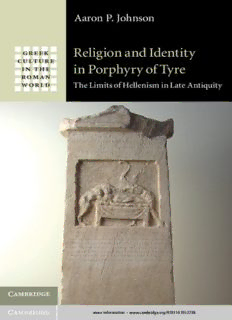
Religion and Identity in Porphyry of Tyre: The Limits of Hellenism in Late Antiquity PDF
Preview Religion and Identity in Porphyry of Tyre: The Limits of Hellenism in Late Antiquity
more information - www.cambridge.org/9781107012738 RELIGION AND IDENTITY IN PORPHYRY OF TYRE Porphyry,anativeofPhoeniciaeducatedinAthensandRomeduring thethirdcenturyad,wasoneofthemostimportantPlatonicphiloso- phersofhisage.Inthisbook,ProfessorJohnsonrejectstheprevailing modern approach to his thought, which has posited an early stage dominatedby“Oriental”superstitionandirrationalityfollowedbya secondrationalizingorHellenizingphaseconsequentuponhismove WestandexposuretoNeoplatonism.Basedonacarefultreatmentof alltherelevantremainsofPorphyry’soriginallyvastcorpus(muchof whichnowsurvivesonlyinfragments),hearguesforacomplexunity ofthoughtintermsofphilosophicaltranslation.Thebookexplores thisphilosopher’scriticalengagementwiththeprocessesofHellenism in late antiquity. It provides the first comprehensive examination of all the strands of Porphyry’s thought that lie at the intersection of religion,theology,ethnicity,andculture. aaron p. johnsonisAssistantProfessorofHumanitiesandClas- sicsatLeeUniversity,workingontheintellectualandculturalhistory oflateantiquity.HeisalsotheauthorofEthnicityandArgumentin Eusebius’PraeparatioEvangelica(2006). greek culture in the roman world Editors susan e. alcock, BrownUniversity jas´ elsner, CorpusChristiCollege,Oxford simon goldhill, UniversityofCambridge TheGreekcultureoftheRomanEmpireoffersarichfieldofstudy.Extraordinaryinsights canbegainedintoprocessesofmulticulturalcontactandexchange,politicalandideological conflict,andthecreativityofachanging,polyglotempire.Duringthisperiod,manyfun- damentalelementsofWesternsocietywerebeingsetinplace:fromtheriseofChristianity, toaninfluentialsystemofeducation,tolong-livedartisticcanons.Thisseriesisthefirst to focus on the response of Greek culture to its Roman imperial setting as a significant phenomenoninitsownright.Tothisend,itwillpublishoriginalandinnovativeresearch intheart,archaeology,epigraphy,history,philosophy,religion,andliteratureoftheempire, withanemphasisonGreekmaterial. Recenttitlesintheseries: GalenandtheWorldofKnowledge EditedbyChristopherGill,TimWhitmarsh,andJohnWilkins LocalKnowledgeandMicroidentitiesintheImperialGreekWorld EditedbyTimWhitmarsh HomerBetweenHistoryandFictioninImperialGreekLiterature LaurenceKim FacingtheGods:EpiphanyandRepresentationinGraeco-RomanArt, LiteratureandReligion VerityPlatt Narrative,IdentityandtheAncientGreekNovel TimWhitmarsh WomenandVisualReplicationinRomanImperialArtandCulture JenniferTrimble TheMaeanderValley:AHistoricalGeographyfromAntiquitytoByzantium PeterThonemann GreeceandtheAugustanCulturalRevolution J.S.Spawforth RethinkingtheGods:PhilosophicalReadingsofReligioninthePost-HellenisticPeriod PeterVanNuffelen SaintsandSymposiasts:TheLiteratureofFoodandtheSymposiumin Greco-RomanandEarlyChristianCulture JasonKo¨nig TheSocialWorldofIntellectualsintheRomanEmpire:Sophists,Philosophers,andChristians KendraEshleman RELIGION AND IDENTITY IN PORPHYRY OF TYRE The Limits of Hellenism in Late Antiquity AARON P. JOHNSON cambridge university press Cambridge,NewYork,Melbourne,Madrid,CapeTown, Singapore,Sa˜oPaulo,Delhi,MexicoCity CambridgeUniversityPress TheEdinburghBuilding,Cambridgecb28ru,UK PublishedintheUnitedStatesofAmericabyCambridgeUniversityPress,NewYork www.cambridge.org Informationonthistitle:www.cambridge.org/9781107012738 (cid:2)c AaronP.Johnson2013 Thispublicationisincopyright.Subjecttostatutoryexception andtotheprovisionsofrelevantcollectivelicensingagreements, noreproductionofanypartmaytakeplacewithoutthewritten permissionofCambridgeUniversityPress. Firstpublished2013 PrintedandboundintheUnitedKingdombytheMPGBooksGroup AcatalogrecordforthispublicationisavailablefromtheBritishLibrary LibraryofCongressCataloginginPublicationdata Johnson,AaronP. ReligionandidentityinPorphyryofTyre:thelimitsofHellenisminlateantiquity/ AaronP.Johnson. pagescm.–(GreekcultureintheRomanworld) Includesbibliographicalreferencesandindex. isbn978-1-107-01273-8 1.Porphyry,ca.234-ca.305. I.Title. b697.z7j64 2013 186(cid:3).4–dc23 2012035050 isbn978-1-107-01273-8Hardback CambridgeUniversityPresshasnoresponsibilityforthepersistenceor accuracyofURLsforexternalorthird-partyinternetwebsitesreferredto inthispublication,anddoesnotguaranteethatanycontentonsuch websitesis,orwillremain,accurateorappropriate. ForHeidi,AlbianandAsher (cid:2)(cid:3)(cid:4)(cid:5)(cid:6)(cid:7)(cid:8)(cid:9)(cid:2)(cid:9)(cid:10)(cid:11)(cid:12)(cid:11)(cid:13)(cid:14)(cid:8)(cid:15)(cid:9)(cid:4) 949 (HomerIliad . ) Contents Acknowledgments pageviii Noteonabbreviations ix 1 AtthelimitsofHellenism:anintroduction 1 part i a world full of gods: porphyry the theologian 2 Porphyry’staxonomyofthedivine 53 3 Salvation,translation,andthelimitsofcult 102 4 Themasterreader:contextsoftranslation 146 part ii a world full of nations: porphyry the ethnographer 5 Knowledgeandnations:Porphyry’sethnicargumentation 189 6 EthnicparticularismandthelimitsofHellenism 222 7 Thewayhome:transcendingparticularism 258 Epilogue:translationafterPorphyry 300 Appendix1:Annotatedtableofselectfragments 307 Appendix2:Translationofselectfragments 331 Workscited 347 Index 372 vii Acknowledgments Porphyrymademanyenemiesinantiquity;Ihavebeenfortunatetohave metmanyfriendswhileworkingonPorphyry.Thisbookandtheresearch onwhichitrestshavebeensustainedbythekindnessandencouragement of colleagues, students, and friends. For a myriad of stimulating conver- sations, criticisms, and advice I am grateful to Chris Faraone, Sebastien Morlet, Margaret Mitchell, Noel Lenski, Scott Johnson, Jack Tannous, JosephMiller,JanghoJo,JohnGrangerCook,ArianeMagny,KateCooper, JaredWielfaert,andGillianClark.HeidiMarx-Wolf,ToddKrulak,Aude Busine, Ilinca Tanaseanu-Do¨bler, and Isha Gamlath kindly provided me with prepublication versions of their own research. Heidi Johnson, Guy Stroumsa,HeidiMarx-Wolf,ToddKrulak,andJohnDillonreadportions of this book and gave much useful insight on improving its shortcom- ings. Of the series editors, Ja´s Elsner gave particularly pointed advice on improvingseverallinesofargument.Myassistant,MelissaPhillips,greatly helpedintheformattingofthemanuscript.Overthepastsixyearsvarious aspectsofmyworkonPorphyrywerepushedandredirectedbyaudiences at: Duke’s Center for Late Antique Studies; two separate meetings of the Shifting Frontiers in Late Antiquity conferences at Boulder and Bloom- ington; the Late Antiquity in Illinois conference at Urbana-Champaign; multiple workshops at the University of Chicago; the Models of Piety in LateAntiquitygroupatthe2008SBL;WashingtonUniversity;University ofParis–Sorbonne;St.DeiniolsLibrary,Hawarden(undertheauspicesof ManchesterCentrefortheStudyofLateAntiquity).Ihavebeenfortunate toreceivethefinancialsupportoftheSocietyofFellowsattheUniversity of Chicago (which provided an excellent context to write the bulk of the presentbook);theNationalEndowmentfortheHumanities;andLeeUni- versityFacultyResearchGrant.Thepositionstakenandanyshortcomings inthefollowingpagesremainmyown.Finally,Imustthankmyfamilyfor goodhumor,persistentlypretendingtobeinterested,andforcingnecessary diversions.Iscarcelydeservetheloveandcommitmenttheyhaveshown. viii
Description: